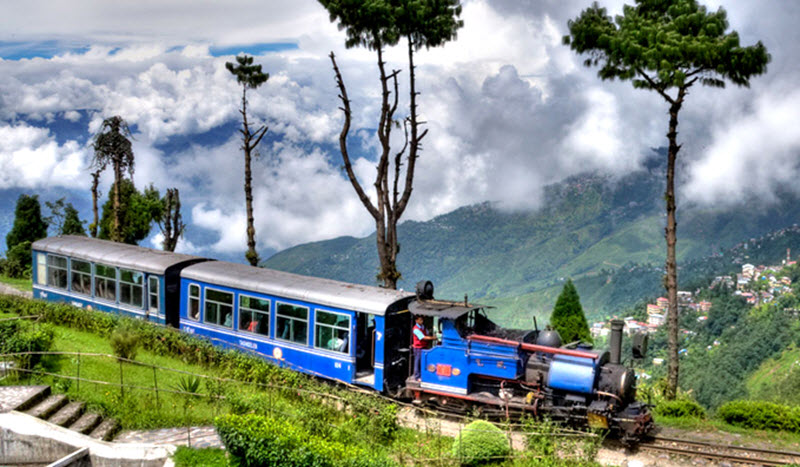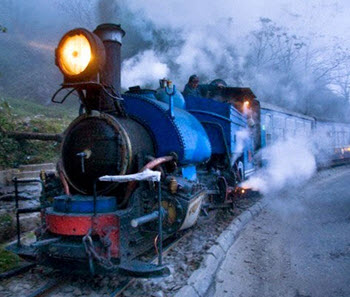
The Darjeeling Himalayan Railway (DHR) is a 610 mm narrow-gauge railway running from Siliguri to Darjeeling in West Bengal, India. Since the trains on the line are so small, it is also known as the Toy Train railway. Opened in the 1880s, it is the oldest hill railway in India and also one of the first hill railways in the whole world. The elevation level varies from just 100 meters above sea level at New Jalpaiguri to about 2,200 meters at Darjeeling.
The DHR is largely true to its original 19th century route and it also uses many of its old steam locomotives. The train is today seen as emblematic of the Darjeeling identity. The Darjeeling Himalayan Railway (DHR) partly follows the old Hill Cart Road to Darjeeling, and for long stretches of your journey the train will be right next to the road.
During some parts of the 78 km long trip, the DHR feels morel like an urban tramway than and overland line, since there are buildings and market stalls right next to the railway. To warn people and animals about the approaching train, the locomotives are equipped with very loud horns and they will honk almost without pause when they go through crowded areas.
History
Background
In the mid 1800s, the colonial administration under the British Raj set up a sanatorium and a military depot in the Darjeeling region in the Himalayas. The idea was to give Brits stationed in India an opportunity to escape from the hot and humid lowlands and rest in the cooler and fresher mountain air 6,700 ft above sea level.
It was soon clear that this cooler climate wasn’t just good for R&R – tea also grew very well up here. As a result, extensive tea plantations were created and trade flourished. People and commodities – including vast amounts of tea – was transported to and from Darjeeling on a little cart-road leading to Siliguri. The journey was neither quick nor comfortable; a railway would be much better. Siliguri was already connected to Calcutta (now Kolkata) by broad gauge railway, so if a railway was built between Siliguri and Darjeeling it would be possible to travel by trains all the way from Darjeeling to Calcutta.
The Easter Bengal Railway Company contacted the government and offered to build a steam tramway between Siliguri and Darjeeling. In 1879, a committee formed by the Lieutenant Governor of Bengal gave the project its support and it was subsequently approved by the government. Construction commenced that same year under the leadership of Gillanders Arbuthnot & Company.
Data & Events
- The line reached Tindharia by March 1880.

- The Siliguri – Kurseong section was opened on 23 August 1880.
- The Siliguri – Darjeeling section was opened 4 July 1881.
- In 1882, four loops and four reverses were constructed between Sukna and Gayabari to make it easier for the train to handle the steepness.
- In 1886, the rail was extended by a quarter of a mile to reach Darjeeling Bazar.
- The Darjeeling station was renovated in 1891.
- In 1896, a new station building and some storage space were built in Kurseong.
- In 1897, the railway was damaged by an earthquake.
- In 1899, the railway was damaged by a cyclone.
- In the early 20th century, the DHR was continually improved to accommodate more and more passengers and goods. Data from 1909-1910 shows that the train carried 174,000 passengers and 47,000 tons of goods in a year.
- An extension up to Kishanganj was built in 1914, followed by an extension to Gielkhola the following year.
- The Batasia Loop was built in 1919.
- The DHR was damaged in the big earthquake of 1934, but was soon repaired and used to transport materials needed to repair the many heavily damaged buildings in the Darjeeling region.
- During World War II, DHR was used to transport military personnel and supplies to the camps around Darjeeling and Ghum.
- After the Indian Independence, the Indian Government purchased DHR and it became a part of the Indian Government Railway. Organisationally, DHR had the same management as the Assam Railways. In 1952, they both became a part of the North Eastern Railway Zone.
- The DHR line was realigned at Siliguri in 1962 and extended by approximately 6 km to reach New Jalpaiguri where it would meet the newly built broad gauge line. The locomotive shed and carriage depot at Siliguri were relocated to New Jalpaiguri.
- In 1988-1989, the DHR trains didn’t run for 18 months due to hostilities connected to the conflict between the Indian government and the Gorkha National Liberation Front.
- DHR was declared a UNESCO World Heritage in 1999.
- The section between Siliguri and Kurseong was temporarily closed in 2010 due to a landslide at Pagla Jhora.
- The DHR was closed for some time after a major earthquake in 2011.
UNESCO World Heritage
The Darjeeling Himalayan Railway was admitted into UNESCO:s list of World Heritage sites in 1999, since it fulfilled criterion ii and iv.
- Criterion ii The Darjeeling Himalayan Railway is an outstanding example of the influence of an innovative transportation system on the social and economic development of a multi-cultural region, which was to serve as a model for similar developments in many parts of the world.
- Criterion iv The development of railways in the 19th century had a profound influence on social and economic developments in many parts of the world. This process is illustrated in an exceptional and seminal fashion by the Darjeeling Himalayan Railway.
Steam locomotives and diesel locomotives
The Darjeeling Himalayan Railway still uses both steam locomotives and diesel locomotives. The diesel locomotives were previously used at the Matheran Hill Railway (MHR), before being transferred to DHR. In March 2001, steam locomotive No. 794 was transferred from DHR to MHR to create a touristy “Joy Train” for the MHR.
The steam locomotives on the DHR are Class B locomotives of a type built by Sharp, Stewart and Company and later the North British Locomotive Company between 1889 and 1925.
The Beeches Light Railway
One of the steam locomotives previously used by the DHR is now in the United Kingdom. It is the No. 778 (originally No. 19). It was first transferred from DHR to Hesston Steam Railway (HSR) in the United States. After many years out of use at the HSR, the locomotive was purchased by a private collector in the UK and restored. It is now based on the private Beeches Light Railway in Oxfordshire, but has also been used on several other railways in the UK – such as the Leighton Buzzard Light Railway and the Lauceston Steam Railway.
Examples of stations on the Darjeeling Himalayan Railway
| Name | Info |
| New Jalpaiquri Junction (NJP) | New Jalpaiquri Junction is located where the DHR meets the broad gauge to Assam. |
| Siliquri Town Station | Originally, this was the southern terminus of the DHR. |
| Siliquri Junction | This became a major station in the 1950s after the construction of the metre-gauge line to Assam. |
| Sukna Station | After Sukna Station, the elevation begins to increase sharply and the open landscape changes into woodland.
There used to be a railway loop in the forest right above Sukna, but it was removed after the flood of 1991. |
| Rangton Station | After Rangton station, the train will reach a water tank, the first reverse and a loop. The loop is at Chunbatti. There will then be two additional reverses before the train reaches Tindharia station. |
| Tindharia Station | This is one of the major railway stations on the DHR and an important station for train maintenance. Workshops are located below the station.
In a separate location in Tindharia, DHR has an engineer’s office and a shed for locomotives. When the train has left Tindharia Station, you will soon get to a loop called Agony Point. This is the tightest curve on the line. |
| Gayabari | After Gayabari, the train reaches the last reverse on the climb. |
| Mahanadi | The Mahanadi is a major river in East Central India. |
| Kurseong Station | This station is a dead end, so the train must reverse out of the station to continue its upwards climb towards Tung Station.
Kurseong Station is where the DHR Archive is, together with DHR exhibits, old photographs and various artefacts. A treasure trove for anyone genuinely interested in the history of the DHR. When the train has left Kurseong Station and continued its climb upwards, it will travel right through a busy bazaar where the vendors have placed their goods right next to the tracks. |
| Tung Station | |
| Sonada Station | |
| Rangbul Station | |
| Jorebungalow Station | Located close to the town Darjeeling. Good connections to Darjeeling.
Tea produced in the Darjeeling area was traditionally stored in Jorebungalow while waiting for transport to Calcutta (Kolkata). |
| Ghum Station | This is the highest railway station in India.
The first floor of the station building includes a museum. There are also exhibitions in the old goods yard. Approximately 5 km from the town of Darjeeling (below Ghum), the train will pass through the Batasia Loop. The track spirals around over itself through a tunnel and over a hilltop. Near the loop is a memorial to Gorkha soldiers. |
Learn more
In February 2010, the BBC showed a series of railway documentaries about Indian Hill Railways – including one film dedicated to the Darjeeling Himalayan Railway. Directed by Tarun Bhartiya, Hugo Smith and Nick Mattingly, the series won the UK Royal Television Society Award in June 2010.
